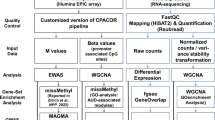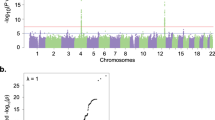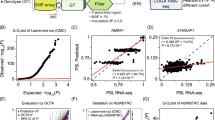Abstract
Genetic factors have as large role as environmental factors in the etiology of alcohol dependence (AD). Although genome-wide association studies (GWAS) enable systematic searches for loci not hitherto implicated in the etiology of AD, many true findings may be missed owing to correction for multiple testing. The aim of the present study was to circumvent this limitation by searching for biological system-level differences, and then following up these findings in humans and animals. Gene-set-based analysis of GWAS data from 1333 cases and 2168 controls identified 19 significantly associated gene-sets, of which 5 could be replicated in an independent sample. Clustered in these gene-sets were novel and previously identified susceptibility genes. The most frequently present gene, ie in 6 out of 19 gene-sets, was X-ray repair complementing defective repair in Chinese hamster cells 5 (XRCC5). Previous human and animal studies have implicated XRCC5 in alcohol sensitivity. This phenotype is inversely correlated with the development of AD, presumably as more alcohol is required to achieve the desired effects. In the present study, the functional role of XRCC5 in AD was further validated in animals and humans. Drosophila mutants with reduced function of Ku80—the homolog of mammalian XRCC5—due to RNAi silencing showed reduced sensitivity to ethanol. In humans with free access to intravenous ethanol self-administration in the laboratory, the maximum achieved blood alcohol concentration was influenced in an allele-dose-dependent manner by genetic variation in XRCC5. In conclusion, our convergent approach identified new candidates and generated independent evidence for the involvement of XRCC5 in alcohol dependence.
Similar content being viewed by others
Log in or create a free account to read this content
Gain free access to this article, as well as selected content from this journal and more on nature.com
or
References
Altenhoff AM, Gil M, Gonnet GH, Dessimoz C (2013). Inferring hierarchical orthologous groups from orthologous gene pairs. PLoS One 8: e53786.
Baik I, Cho NH, Kim SH, Han BG, Shin C (2011). Genome-wide association studies identify genetic loci related to alcohol consumption in Korean men. Am J Clin Nutr 93: 809–816.
Bierut LJ, Agrawal A, Bucholz KK, Doheny KF, Laurie C, Pugh E et al (2010). A genome-wide association study of alcohol dependence. Proc Natl Acad Sci USA 107: 5082–5087.
Bhave SV, Hoffman PL, Lassen N, Vasiliou V, Saba L, Deitrich RA et al (2006). Gene array profiles of alcohol and aldehyde metabolizing enzymes in brains of C57BL/6 and DBA/2 mice. Alcohol Clin Exp Res 30: 1659–1669.
Carr LG, Kimpel MW, Liang T, McClintick JN, McCall K, Morse M et al (2007). Identification of candidate genes for alcohol preference by expression profiling of congenic rat strains. Alcohol Clin Exp Res 31: 1089–1098.
Crabbe JC, Bell RL, Ehlers CL (2010). Human and laboratory rodent low response to alcohol: is better consilience possible? Addict Biol 15: 125–144.
De Zio D, Bordi M, Cecconi F (2012). Oxidative DNA damage in neurons: implication of ku in neuronal homeostasis and survival. Int J Cell Biol 2012: 752420.
Deelen J, Uh HW, Monajemi R, van Heemst D, Thijssen PE, Bohringer S et al (2013). Gene set analysis of GWAS data for human longevity highlights the relevance of the insulin/IGF-1 signaling and telomere maintenance pathways. Age (Dordr) 35: 235–249.
Downs JA, Jackson SP (2004). A means to a DNA end: the many roles of Ku. Nat Rev Mol Cell Biol 5: 367–378.
Edenberg HJ, Koller DL, Xuei X, Wetherill L, McClintick JN, Almasy L et al (2010). Genome-wide association study of alcohol dependence implicates a region on chromosome 11. Alcohol Clin Exp Res 34: 840–852.
Frank J, Cichon S, Treutlein J, Ridinger M, Mattheisen M, Hoffmann P et al (2012). Genome-wide significant association between alcohol dependence and a variant in the ADH gene cluster. Addict Biol 17: 171–180.
Gelernter J, Kranzler HR, Sherva R, Almasy L, Koesterer R, Smith AH et al (2013a). Genome-wide association study of alcohol dependence: significant findings in African- and European-Americans including novel risk loci. Mol Psychiatry 19: 41–49.
Gelernter J, Kranzler HR, Sherva R, Koesterer R, Almasy L, Zhao H et al (2013b). Genome-wide association study of opioid dependence: multiple associations mapped to calcium and potassium pathways. Biol Psychiatry 76: 66–74.
Gelernter J, Sherva R, Koesterer R, Almasy L, Zhao H, Kranzler HR et al (2013c). Genome-wide association study of cocaine dependence and related traits: FAM53B identified as a risk gene. Mol Psychiatry 19: 717–723.
Goeman JJ, van de Geer SA, de Kort F, van Houwelingen HC (2004). A global test for groups of genes: testing association with a clinical outcome. Bioinformatics 20: 93–99.
Gruber JD, Genissel A, Macdonald SJ, Long AD (2007). How repeatable are associations between polymorphisms in achaete-scute and bristle number variation in Drosophila? Genetics 175: 1987–1997.
Han S, Yang BZ, Kranzler HR, Liu X, Zhao H, Farrer LA et al (2013). Integrating GWASs and human protein interaction networks identifies a gene subnetwork underlying alcohol dependence. Am J Hum Genet 93: 1027–1034.
Hargreaves GA, Quinn H, Kashem MA, Matsumoto I, McGregor IS (2009). Proteomic analysis demonstrates adolescent vulnerability to lasting hippocampal changes following chronic alcohol consumption. Alcohol Clin Exp Res 33: 86–94.
Hoffmann AA, Cohan FM (1987). Olfactory responses of Drosophila melanogaster selected for knockdown resistance to ethanol. Behav Genet 17: 307–312.
Jia P, Zheng S, Long J, Zheng W, Zhao Z (2011). dmGWAS: dense module searching for genome-wide association studies in protein-protein interaction networks. Bioinformatics 27: 95–102.
Johnson C, Drgon T, Liu QR, Walther D, Edenberg H, Rice J et al (2006). Pooled association genome scanning for alcohol dependence using 104 268 SNPs: validation and use to identify alcoholism vulnerability loci in unrelated individuals from the collaborative study on the genetics of alcoholism. Am J Med Genet B Neuropsychiatr Genet 141B: 844–853.
Joslyn G, Ravindranathan A, Brush G, Schuckit M, White RL (2010). Human variation in alcohol response is influenced by variation in neuronal signaling genes. Alcohol Clin Exp Res 34: 800–812.
Juraeva D, Haenisch B, Zapatka M, Frank J et al GROUP Investigators, iPSYCH-GEMS SCZ working group (2014). Integrated pathway-based approach identifies association between genomic regions at CTCF and CACNB2 and schizophrenia. PLoS Genet 10: e1004345.
Kendler KS, Kalsi G, Holmans PA, Sanders AR, Aggen SH, Dick DM et al (2011). Genomewide association analysis of symptoms of alcohol dependence in the molecular genetics of schizophrenia (MGS2) control sample. Alcohol Clin Exp Res 35: 963–975.
Kimpel MW, Strother WN, McClintick JN, Carr LG, Liang T, Edenberg HJ et al (2007). Functional gene expression differences between inbred alcohol-preferring and -non-preferring rats in five brain regions. Alcohol 41: 95–132.
King AC, de Wit H, McNamara PJ, Cao D (2011). Rewarding, stimulant, and sedative alcohol responses and relationship to future binge drinking. Arch Gen Psychiatry. 68: 389–399.
King AC, McNamara PJ, Hasin DS, Cao D (2014). Alcohol challenge responses predict future alcohol use disorder symptoms: a 6-year prospective study. Biol Psychiatry. 75: 798–806.
Klouckova I, Hrncirova P, Mechref Y, Arnold RJ, Li TK, McBride WJ et al (2006). Changes in liver protein abundance in inbred alcohol-preferring rats due to chronic alcohol exposure, as measured through a proteomics approach. Proteomics 6: 3060–3074.
Kovanen L, Saarikoski ST, Haukka J, Pirkola S, Aromaa A, Lonnqvist J et al (2010). Circadian clock gene polymorphisms in alcohol use disorders and alcohol consumption. Alcohol Alcohol 45: 303–311.
Lasek AW, Lim J, Kliethermes CL, Berger KH, Joslyn G, Brush G et al (2011). An evolutionary conserved role for anaplastic lymphoma kinase in behavioral responses to ethanol. PLoS One 6: e22636.
Li D, Zhao H, Gelernter J (2011). Strong association of the alcohol dehydrogenase 1B gene (ADH1B) with alcohol dependence and alcohol-induced medical diseases. Biol Psychiatry 70: 504–512.
Li D, Zhao H, Gelernter J (2012). Further clarification of the contribution of the ADH1C gene to vulnerability of alcoholism and selected liver diseases. Hum Genet 131: 1361–1374.
Li H, Coghlan A, Ruan J, Coin LJ, Heriche JK, Osmotherly L et al (2006). TreeFam: a curated database of phylogenetic trees of animal gene families. Nucleic Acids Res 34 (Database issue): D572–D580.
Liang T, Kimpel MW, McClintick JN, Skillman AR, McCall K, Edenberg HJ et al (2010). Candidate genes for alcohol preference identified by expression profiling in alcohol-preferring and -nonpreferring reciprocal congenic rats. Genome Biol 11: R11.
Lin PI, Vance JM, Pericak-Vance MA, Martin ER (2007). No gene is an island: the flip-flop phenomenon. Am J Hum Genet 80: 531–538.
MacLaren EJ, Bennett B, Johnson TE, Sikela JM (2006). Expression profiling identifies novel candidate genes for ethanol sensitivity QTLs. Mamm Genome 17: 147–156.
Maher BS, Reimers MA, Riley BP, Kendler KS (2010). Allelic heterogeneity in genetic association meta-analysis: an application to DTNBP1 and schizophrenia. Hum Hered 69: 71–79.
McKay JD, Truong T, Gaborieau V, Chabrier A, Chuang SC, Byrnes G et al (2011). A genome-wide association study of upper aerodigestive tract cancers conducted within the INHANCE consortium. PLoS Genet 7: e1001333.
Moore MS, DeZazzo J, Luk AY, Tully T, Singh CM, Heberlein U (1998). Ethanol intoxication in Drosophila: Genetic and pharmacological evidence for regulation by the cAMP signaling pathway. Cell 93: 997–1007.
Mulligan MK, Ponomarev I, Hitzemann RJ, Belknap JK, Tabakoff B, Harris RA et al (2006). Toward understanding the genetics of alcohol drinking through transcriptome meta-analysis. Proc Natl Acad Sci USA 103: 6368–6373.
Nei M, Xu P, Glazko G (2001). Estimation of divergence times from multiprotein sequences for a few mammalian species and several distantly related organisms. Proc Natl Acad Sci USA 98: 2497–2502.
Newlin DB, Renton RM (2010). High risk groups often have higher levels of alcohol response than low risk: the other side of the coin. Alcohol Clin Exp Res 34: 199–202.
Pan Y, Luo X, Liu X, Wu LY, Zhang Q, Wang L et al (2013). Genome-wide association studies of maximum number of drinks. J Psychiatr Res 47: 1717–1724.
Park BL, Kim JW, Cheong HS, Kim LH, Lee BC, Seo CH et al (2013). Extended genetic effects of ADH cluster genes on the risk of alcohol dependence: from GWAS to replication. Hum Genet 132: 657–668.
Pei YF, Zhang L, Yang TL, Han Y, Hai R, Ran S et al (2012). Genome-wide association study of copy number variants suggests LTBP1 and FGD4 are important for alcohol drinking. PLoS One 7: e30860.
Prescott CA, Kendler KS (1999). Genetic and environmental contributions to alcohol abuse and dependence in a population-based sample of male twins. Am J Psychiatry 156: 34–40.
Quillen EE, Chen XD, Almasy L, Yang F, He H, Li X et al (2014). ALDH2 is associated to alcohol dependence and is the major genetic determinant of ‘daily maximum drinks’ in a GWAS study of an isolated rural Chinese sample. Am J Med Genet B Neuropsychiatr Genet 165B: 103–110.
Rietschel M, Treutlein J (2013). The genetics of alcohol dependence. Ann NY Acad Sci 1282: 39–70.
Robinson TE, Berridge KC (2000). The psychology and neurobiology of addiction: an incentive-sensitization view. Addiction 95 (Suppl 2): S91–117.
Rodd ZA, Kimpel MW, Edenberg HJ, Bell RL, Strother WN, McClintick JN et al (2008). Differential gene expression in the nucleus accumbens with ethanol self-administration in inbred alcohol-preferring rats. Pharmacol Biochem Behav 89: 481–498.
Scholz H (2009). Intoxicated fly brains: neurons mediating ethanol-induced behaviors. J Neurogenet 23: 111–119.
Schuckit MA (1994). Low level of response to alcohol as a predictor of future alcoholism. Am J Psychiatry 151: 184–189.
Schuckit MA, Edenberg HJ, Kalmijn J, Flury L, Smith TL, Reich T et al (2001). A genome-wide search for genes that relate to a low level of response to alcohol. Alcohol Clin Exp Res 25: 323–329.
Schuckit MA, Smith TL, Kalmijn J (2004). The search for genes contributing to the low level of response to alcohol: patterns of findings across studies. Alcohol Clin Exp Res 28: 1449–1458.
Schumann G, Coin LJ, Lourdusamy A, Charoen P, Berger KH, Stacey D et al (2011). Genome-wide association and genetic functional studies identify autism susceptibility candidate 2 gene (AUTS2) in the regulation of alcohol consumption. Proc Natl Acad Sci USA 108: 7119–7124.
Sherva R, Rice JP, Neuman RJ, Rochberg N, Saccone NL, Bierut LJ (2009). Associations and interactions between SNPs in the alcohol metabolizing genes and alcoholism phenotypes in European Americans. Alcohol Clin Exp Res 33: 848–857.
Siler SQ, Neese RA, Christiansen MP, Hellerstein MK (1998). The inhibition of gluconeogenesis following alcohol in humans. Am J Physiol 275 (5 Pt 1): E897–E907.
Slater SJ, Cook AC, Seiz JL, Malinowski SA, Stagliano BA, Stubbs CD (2003). Effects of ethanol on protein kinase C alpha activity induced by association with Rho GTPases. Biochemistry 42: 12105–12114.
Sommer W, Arlinde C, Caberlotto L, Thorsell A, Hyytia P, Heilig M (2001). Differential expression of diacylglycerol kinase iota and L18A mRNAs in the brains of alcohol-preferring AA and alcohol-avoiding ANA rats. Mol Psychiatry 6: 103–108 105.
Spanagel R, Durstewitz D, Hansson A, Heinz A, Kiefer F, Kohr G et al (2013). A systems medicine research approach for studying alcohol addiction. Addict Biol 18: 883–896.
Spanagel R (2013). Convergent functional genomics in addiction research—a translational approach to study candidate genes and gene networks. In Silico Pharmacology 1: 18.
Sullivan PF, Daly MJ, O'Donovan M (2012). Genetic architectures of psychiatric disorders: the emerging picture and its implications. Nat Rev Genet 13: 537–551.
Takeuchi F, Isono M, Nabika T, Katsuya T, Sugiyama T, Yamaguchi S et al (2011). Confirmation of ALDH2 as a Major locus of drinking behavior and of its variants regulating multiple metabolic phenotypes in a Japanese population. Circ J 75: 911–918.
Treutlein J, Cichon S, Ridinger M, Wodarz N, Soyka M, Zill P et al (2009). Genome-wide association study of alcohol dependence. Arch Gen Psychiatry 66: 773–784.
Veyrieras JB, Kudaravalli S, Kim SY, Dermitzakis ET, Gilad Y, Stephens M et al (2008). High-resolution mapping of expression-QTLs yields insight into human gene regulation. PLoS Genet 4: e1000214.
Wetherill L, Kapoor M, Agrawal A, Bucholz K, Koller D, Bertelsen SE et al (2013). Family-based association analysis of alcohol dependence criteria and severity. Alcohol Clin Exp Res 38: 354–366.
Zimmermann US, Mick I, Laucht M, Vitvitskiy V, Plawecki MH, Mann KF et al (2009). Offspring of parents with an alcohol use disorder prefer higher levels of brain alcohol exposure in experiments involving computer-assisted self-infusion of ethanol (CASE). Psychopharmacology 202: 689–697.
Zuo L, Wang K, Zhang XY, Krystal JH, Li CS, Zhang F et al (2013). NKAIN1-SERINC2 is a functional, replicable and genome-wide significant risk gene region specific for alcohol dependence in subjects of European descent. Drug Alcohol Depend 129: 254–264.
Acknowledgements
We thank Christine Hohmeyer for her expert technical assistance. We also thank Prof TG Schulze, MD, from the Georg-August-University Göttingen for helpful discussions. We thank the journal reviewers for their valuable suggestions for improving the manuscript.
Author information
Authors and Affiliations
Corresponding author
Additional information
Supplementary Information accompanies the paper on the Neuropsychopharmacology website
PowerPoint slides
Rights and permissions
About this article
Cite this article
Juraeva, D., Treutlein, J., Scholz, H. et al. XRCC5 as a Risk Gene for Alcohol Dependence: Evidence from a Genome-Wide Gene-Set-Based Analysis and Follow-up Studies in Drosophila and Humans. Neuropsychopharmacol 40, 361–371 (2015). https://doi.org/10.1038/npp.2014.178
Received:
Revised:
Accepted:
Published:
Issue date:
DOI: https://doi.org/10.1038/npp.2014.178
This article is cited by
-
Genetische Aspekte bei Alkoholismus
BIOspektrum (2018)



